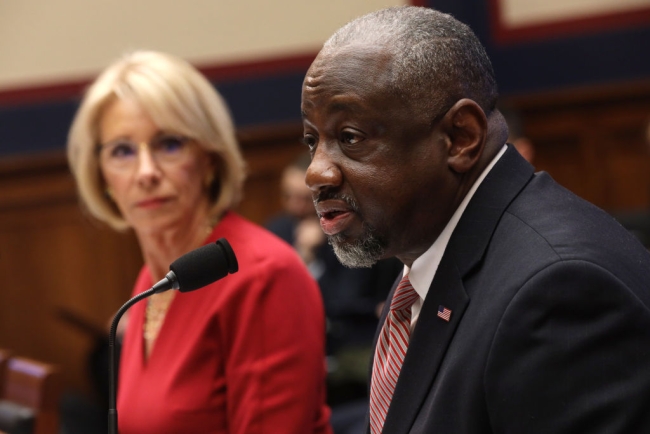You have /5 articles left.
Sign up for a free account or log in.

General Mark Brown (right), with former secretary Betsy DeVos
Alex Wong / Getty Images
The chief operating officer of Federal Student Aid, retired Air Force general Mark Brown, resigned Friday. Brown was responsible for overseeing the agency’s trillion-dollar loan portfolio, a job that will be held in the interim by Robin Minor. Minor is currently the COO for partner participation and oversight. Last week also saw technical problems with federal student aid application sites.
“I accepted the resignation of Federal Student Aid Chief Operating Officer Gen. Mark Brown and thanked him for his service to the U.S. Department of Education. As the nation continues grappling with economic disruptions caused by the COVID-19 pandemic, the need to deliver relief and fortify pathways to the middle class is more urgent than ever,” said Education Secretary Miguel Cardona in a written statement. “In service to our nation’s students, the department’s Federal Student Aid division will renew its focus on streamlining access to and management of federal financial aid, easing the burden of student debt, and carefully stewarding taxpayer dollars.”
Brown was appointed to the position by Education Secretary Betsy DeVos in 2019. After the inauguration of President Biden, he had faced pressure by Senator Elizabeth Warren and consumer groups to vacate the position.
"Whether it was incompetence, malice, or a mix of both, the Department of Education's student loan bank under Betsy DeVos was a disaster and oversaw the illegal garnishment of the wages of thousands of struggling borrowers during the pandemic,” said Warren in a written statement, referring to the mismanagement by the department of a federal order to cease involuntary collections on student loan debt during the emergency. “The resignation of FSA Chief Operating Officer Major General Mark Brown is good for American borrowers.”
Meanwhile, last week, the Free Application for Federal Student Aid portal experienced technical difficulties, potentially impacting the ability of students to submit their applications before state deadlines. Nothing so far suggests the website’s problems are connected to Brown’s departure.
James Snider, who helps Tennessee students navigate the state’s scholarship program, said his office was inundated last week with calls about the website glitch. Tennessee Promise, the state program, maintains a hotline for students and families to call about submitting the FAFSA. On March 1, the program’s deadline to submit, about half of the day’s 80 calls were related to problems with FAFSA.
The website glitch affects the ability of applicants to submit their information. While students can input their information into the form, submitting brings up an error message.
Snider said that students who called the hotline were usually able to complete their applications eventually. But he said he’s concerned about those who don’t reach out or don’t have the perseverance to try to submit several times.
“If a student steps away, they may not come back in a timely manner to meet the deadline,” he said.

As frustrated students took to social media to vent and fret about the problem, the FSA counseled them, online and elsewhere, to try using the program’s app, using a different browser, clearing their browser cache or submitting an application for renewal as a new application instead.
While those tactics seemed to work for some students, they did not for others.
Snider said that at Tennessee Promise, the state's program for free community college, officials have been able to bring most students who call over the finish line, but there are a few who haven’t been able to overcome the glitch. The program is keeping a list of those students and extended its application deadline to March 15.
“If I’ve attempted five, six, or 10 times,” Snider said, “I would be frustrated.”
The Education Department has said that the FAFSA site is not down, but they are aware that some users haven’t been able to complete certain actions.
Officials at the California State University system, which had a March 2 deadline, said they were not aware of the problem and had not been contacted by the department about it. Officials at the University of Virginia, which had a March 1 deadline, said they were aware of the issue and know that the department is working to fix it. As of Thursday, the university had only heard from one student about the problem.
“That said, we sympathize with the worry and frustration that any students might experience as a result of this technical difficulty and we make every effort to keep students from being harmed by circumstances beyond their control,” said a UVA spokesperson via email. “While our filing deadline was March 1, we do not cut anyone off from financial aid if they miss the deadline, and we continue to encourage submission of aid applications, including email and text reminders to students.”
High school seniors, especially those from schools serving low-income and minority students, are behind on filling out the FAFSA this year compared to previous years, possibly indicating a decreasing likelihood of attending college.








